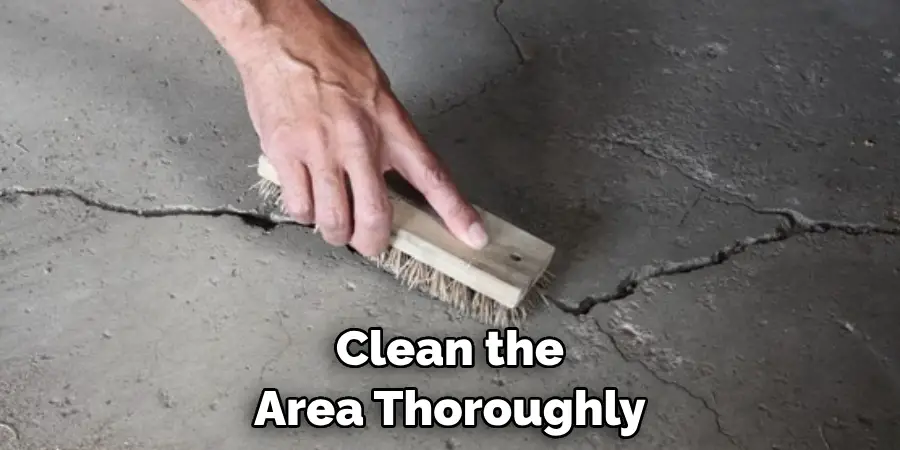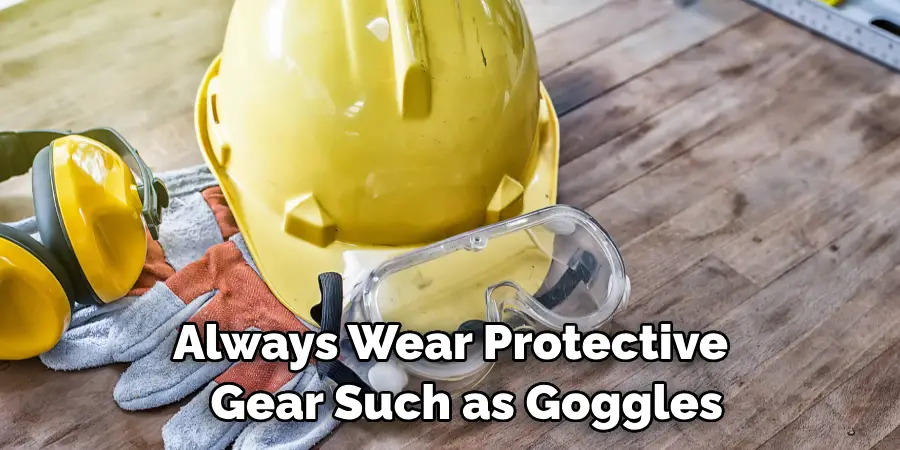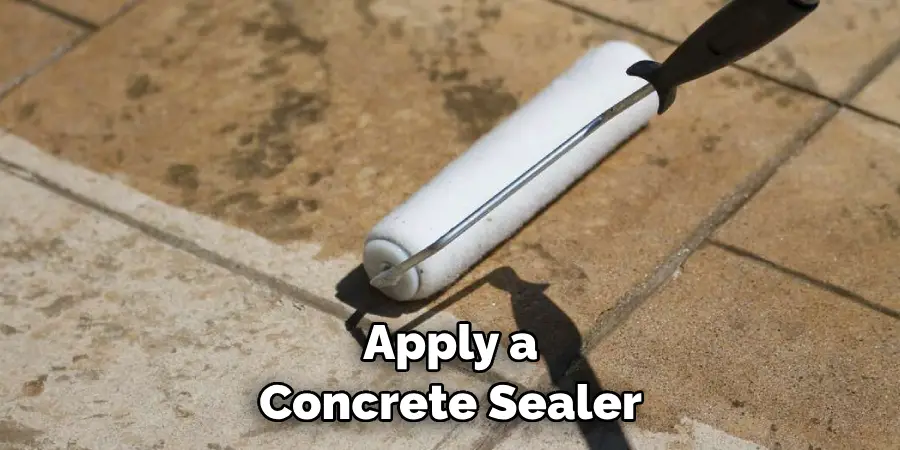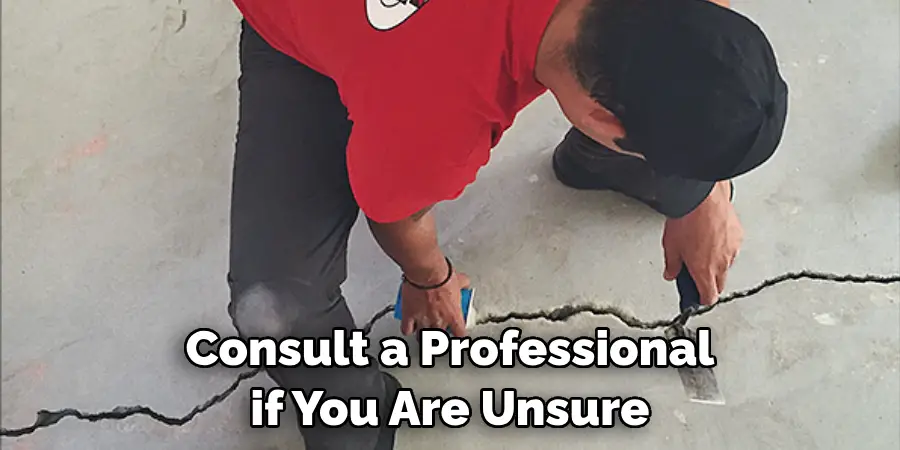Having holes in your garage floor can be a major inconvenience. Not only do they look unsightly, but they can also create tripping hazards and damage to your vehicles or other possessions stored in the garage. Therefore, it is important to know to fix holes in garage floor to maintain safety and aesthetics in your space.

The main advantage of fixing holes in garage floor is that you can save a lot of money on repairs. Garage floors are prone to damages such as cracks and holes due to constant stress from heavy vehicles, oil spills, and other factors. If left unattended, these holes can expand into bigger problems and may even lead to costly replacements. Read this blog post to learn how to fix holes in garage floor.
Step-by-step Instructions for How to Fix Holes in Garage Floor
Step 1: Inspect the Damage
The first step in fixing holes in your garage floor is to assess the damage. Look for any cracks, chips, or missing pieces of concrete. You may need to clean the area with a wire brush or pressure washer to get a better look at the damage.
Step 2: Gather Materials
To fix holes in your garage floor, you will need some materials including a concrete patch, bonding agent, trowel, and a bucket for mixing. You may also need a wire mesh if the hole is larger than 1 inch in diameter.
Step 3: Prepare the Area
Before starting any repairs, make sure to clean the area thoroughly. Remove any debris or loose concrete and use a degreaser to remove any oil or grease stains. This will ensure that the patch adheres properly to the surface.

Step 4: Mix Concrete Patch
Follow the instructions on the concrete patch packaging to mix it with water in a bucket. You want to achieve a smooth, thick consistency that can be easily spread with a trowel. For larger holes, it is recommended to use a bonding agent to ensure the patch adheres properly. Apply the bonding agent to the edges of the hole using a paintbrush.
Step 5: Add Wire Mesh
For holes that are larger than 1 inch in diameter, you will need to add a wire mesh for added support. Cut the mesh slightly smaller than the size of the hole and place it on top of the bonding agent. Using a trowel, begin filling the hole with the concrete patch. Make sure to fill it completely and use the trowel to smooth out the surface.
Step 6: Let it Dry
Allow the patch to dry according to the instructions on the packaging. This usually takes at least 24 hours. Once the patch is completely dry, sand down any rough edges using sandpaper. Then, apply a concrete sealer to protect the patch from future damage.
Step 7: Regular Maintenance
To prevent future holes in your garage floor, it is important to regularly maintain and clean the surface. This includes removing any oil or grease stains and filling in any small cracks before they become bigger problems.
By following these simple steps, you can easily fix holes in your garage floor and ensure a smooth and safe surface for years to come. Remember to always follow safety precautions when working with concrete and seek professional help if needed.
Precautions for How to Fix Holes in Garage Floor
- Always wear protective gear such as goggles, gloves and work boots while working on your garage floor. This ensures that you are safe from any hazards and prevents injuries in case of accidents.
- Ensure sufficient ventilation in your garage when working with chemicals or using power tools to fix holes. The fumes from the chemicals can be toxic if inhaled, while power tools can generate dust which can be hazardous if not properly ventilated.
- When working on your garage floor, keep children and pets away from the area. This will prevent them from coming into contact with any dangerous chemicals or being injured by any tools or equipment.
- Before you start fixing holes in your garage floor, ensure that the area is clean and free from clutter. This will make it easier for you to work and prevent any accidents caused by tripping over objects.
- When working with chemicals, always read the instructions carefully and follow them accordingly. Some chemicals can be hazardous if not used in the correct way, so it is important to understand how to use them safely.
- Use proper tools and equipment for the job. This includes using a respirator when dealing with dust or fumes, and wearing knee pads to protect your knees when working on the floor.
- If you are unsure about how to fix holes in your garage floor, it is best to seek professional help. This will ensure that the job is done correctly and safely, and prevent any potential damage or safety hazards. Plus, seeking professional help can save you time and effort in trying to fix the holes yourself.

By following these precautions, you can ensure a safe and successful experience when fixing holes in your garage floor. Remember to always prioritize your safety and take necessary precautions to prevent any accidents or injuries.
Are There Any Long-term Maintenance Tips for Preventing Holes in Your Garage Floor?
Fixing holes in your garage floor not only ensures its safety and longevity but also helps maintain the overall aesthetics of your garage. However, once you have fixed the current hole, it is important to take preventive measures to avoid any future holes from forming. Here are some long-term maintenance tips for preventing holes in your garage floor.
- Keep Your Garage Floor Clean and Dry: One of the main reasons for cracks and holes in a garage floor is water seepage. This can occur due to cracks in the foundation or improper drainage. To prevent this, ensure that your garage floor is always clean and dry. Sweep away any debris or standing water regularly.
- Use a Good Quality Sealer: Sealing your garage floor can help protect it from moisture and other forms of damage. Make sure to use a high-quality sealer specifically designed for concrete floors. You can also add an anti-slip additive to make your garage floor safer.
- Avoid Using Harsh Chemicals: Certain chemicals such as gasoline, oil, or de-icing salts can cause damage to your garage floor. Try to avoid spilling these substances and if you do, make sure to clean them up immediately.
- Repair Cracks and Holes Promptly: As soon as you notice any cracks or holes in your garage floor, it is important to address them immediately. The longer you wait, the worse the damage can become. Use a suitable concrete filler or patching compound to fix any holes or cracks.
- Protect High Traffic Areas: If certain areas of your garage floor are constantly subjected to heavy usage, consider using protective mats or tiles to prevent wear and tear. This will not only protect your garage floor but also make it easier to clean.

In conclusion, fixing holes in your garage floor is essential for its safety and longevity. However, taking preventive measures can go a long way in avoiding any future damage. By following these maintenance tips, you can ensure that your garage floor remains free from holes and other forms of damage for years to come.
How Can You Prevent Water From Seeping Into the Repaired Area and Causing Further Damage?
Preventing water from seeping into the repaired area is crucial to ensure that the garage floor remains strong and durable after fixing any holes. Here are some tips to help you prevent water damage:
1. Use a Concrete Sealer
After repairing the holes in your garage floor, it’s essential to apply a concrete sealer to protect the surface from water penetration. The sealer creates a waterproof barrier, preventing water from seeping into the repaired area and causing further damage. Make sure to choose a high-quality concrete sealer that is suitable for garage floors.

2. Fix Any Cracks or Gaps
Before applying the sealer, make sure to fill in any cracks or gaps in the floor with a concrete patching compound. This will ensure that the sealer can properly adhere to the surface and provide maximum protection against water.
3. Check for Proper Drainage
Ensure that your garage floor has proper drainage to prevent standing water from accumulating near the repaired area. If there are any areas with poor drainage, consider installing a drain or creating a slope to redirect water away from the floor.
4. Keep Gutters Clean
Make sure to regularly clean and maintain your gutters to prevent water from overflowing and seeping into the garage floor. Clogged gutters can cause water to pool near the foundation of your home, leading to potential leaks and damage.
5. Fix Any Foundation Issues
If you notice any cracks or damage in the foundation of your home, it’s crucial to address them as soon as possible. These issues can allow water to seep into the garage floor and cause further damage. Consult a professional if you are unsure how to properly fix any foundation problems.

By following these tips, you can prevent water from seeping into the repaired area and causing further damage to your garage floor. Remember to regularly inspect your garage floor for signs of water damage and address any issues promptly to maintain a strong and durable surface.
Are There Any Environmental Concerns When Using Certain Types of Filler or Cement?
There are many different types of filler and cement available on the market for fixing holes in garage floors. However, when choosing a product to use, it’s important to consider any potential environmental concerns associated with its use.
Some products may contain harmful chemicals or emit noxious fumes during application, which can be damaging to both human health and the environment. These materials should be used with caution and in accordance with safety guidelines.
Fortunately, there are also eco-friendly options available for fixing holes in garage floors. For example, some products are made from natural materials such as plant-based resins or recycled materials.
These options may be more sustainable and less harmful to the environment. Another important factor to consider is the disposal of any excess filler or cement. It’s important to properly dispose of these materials according to local regulations, in order to prevent any harm to the environment.
Conclusion
In conclusion, fixing holes in your garage floor is a relatively simple task that can save you time and money in the long run. With the right tools and materials, anyone can successfully repair their garage floor without having to hire a professional. First and foremost, it’s important to identify the cause of the hole so you can prevent future damage.
Whether it was caused by heavy objects or water damage, addressing the root of the problem will prevent any future holes from forming.
Next, gather all the necessary tools and materials including a chisel, hammer, concrete patching compound, trowel, and protective gear such as gloves and safety glasses.
It’s important to have these items on hand before starting the repair process. I hope this article has been beneficial for learning how to fix holes in garage floor. Make Sure the precautionary measures are followed chronologically.
